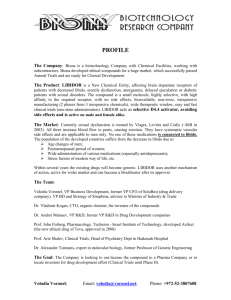REPORT Maladaptive conflict monitoring as evidence for executive
advertisement
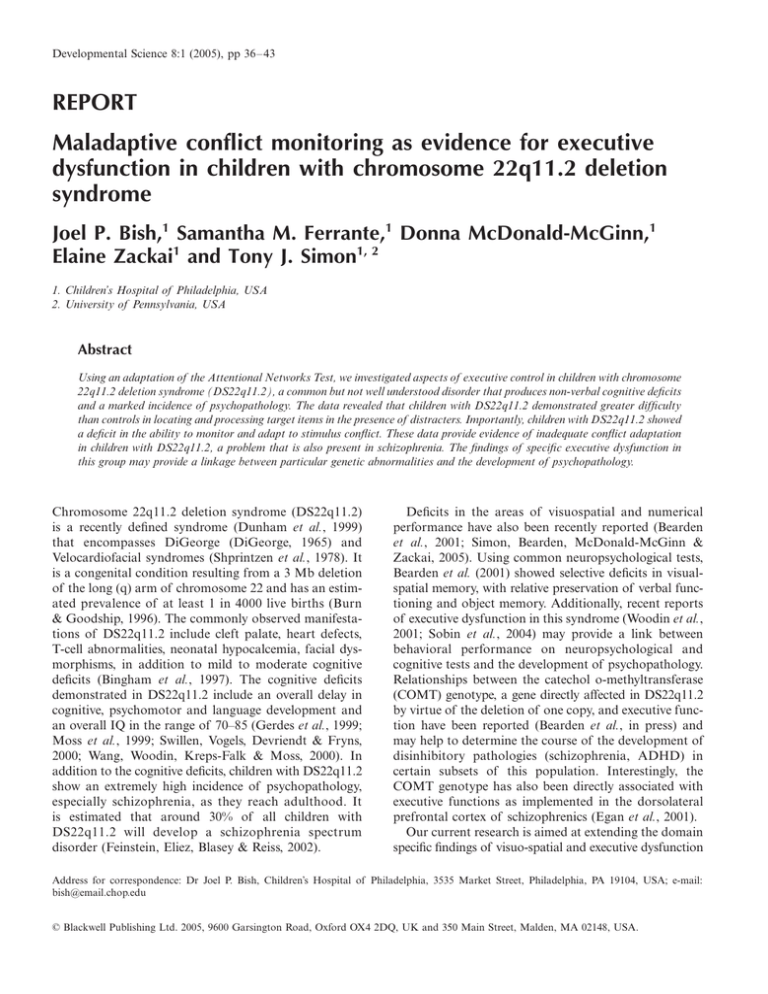
Developmental Science 8:1 (2005), pp 36– 43 REPORT Blackwell Publishing, Ltd. Maladaptive conflict monitoring as evidence for executive dysfunction in children with chromosome 22q11.2 deletion syndrome Joel P. Bish,1 Samantha M. Ferrante,1 Donna McDonald-McGinn,1 Elaine Zackai1 and Tony J. Simon1, 2 1. Children’s Hospital of Philadelphia, USA 2. University of Pennsylvania, USA Abstract Using an adaptation of the Attentional Networks Test, we investigated aspects of executive control in children with chromosome 22q11.2 deletion syndrome (DS22q11.2), a common but not well understood disorder that produces non-verbal cognitive deficits and a marked incidence of psychopathology. The data revealed that children with DS22q11.2 demonstrated greater difficulty than controls in locating and processing target items in the presence of distracters. Importantly, children with DS22q11.2 showed a deficit in the ability to monitor and adapt to stimulus conflict. These data provide evidence of inadequate conflict adaptation in children with DS22q11.2, a problem that is also present in schizophrenia. The findings of specific executive dysfunction in this group may provide a linkage between particular genetic abnormalities and the development of psychopathology. Chromosome 22q11.2 deletion syndrome (DS22q11.2) is a recently defined syndrome (Dunham et al., 1999) that encompasses DiGeorge (DiGeorge, 1965) and Velocardiofacial syndromes (Shprintzen et al., 1978). It is a congenital condition resulting from a 3 Mb deletion of the long (q) arm of chromosome 22 and has an estimated prevalence of at least 1 in 4000 live births (Burn & Goodship, 1996). The commonly observed manifestations of DS22q11.2 include cleft palate, heart defects, T-cell abnormalities, neonatal hypocalcemia, facial dysmorphisms, in addition to mild to moderate cognitive deficits (Bingham et al., 1997). The cognitive deficits demonstrated in DS22q11.2 include an overall delay in cognitive, psychomotor and language development and an overall IQ in the range of 70–85 (Gerdes et al., 1999; Moss et al., 1999; Swillen, Vogels, Devriendt & Fryns, 2000; Wang, Woodin, Kreps-Falk & Moss, 2000). In addition to the cognitive deficits, children with DS22q11.2 show an extremely high incidence of psychopathology, especially schizophrenia, as they reach adulthood. It is estimated that around 30% of all children with DS22q11.2 will develop a schizophrenia spectrum disorder (Feinstein, Eliez, Blasey & Reiss, 2002). Deficits in the areas of visuospatial and numerical performance have also been recently reported (Bearden et al., 2001; Simon, Bearden, McDonald-McGinn & Zackai, 2005). Using common neuropsychological tests, Bearden et al. (2001) showed selective deficits in visualspatial memory, with relative preservation of verbal functioning and object memory. Additionally, recent reports of executive dysfunction in this syndrome (Woodin et al., 2001; Sobin et al., 2004) may provide a link between behavioral performance on neuropsychological and cognitive tests and the development of psychopathology. Relationships between the catechol o-methyltransferase (COMT) genotype, a gene directly affected in DS22q11.2 by virtue of the deletion of one copy, and executive function have been reported (Bearden et al., in press) and may help to determine the course of the development of disinhibitory pathologies (schizophrenia, ADHD) in certain subsets of this population. Interestingly, the COMT genotype has also been directly associated with executive functions as implemented in the dorsolateral prefrontal cortex of schizophrenics (Egan et al., 2001). Our current research is aimed at extending the domain specific findings of visuo-spatial and executive dysfunction Address for correspondence: Dr Joel P. Bish, Children’s Hospital of Philadelphia, 3535 Market Street, Philadelphia, PA 19104, USA; e-mail: bish@email.chop.edu © Blackwell Publishing Ltd. 2005, 9600 Garsington Road, Oxford OX4 2DQ, UK and 350 Main Street, Malden, MA 02148, USA. Attentional dysfunction and 22q11.2 in this population. Our method is to use cognitive processing tasks designed to directly interrogate the neural structures underlying the functional deficits shown in this group. We recently reported deficits in spatial orienting, enumeration and magnitude comparison in children with DS22q11.2 (Simon et al., in press). These tasks were selected because each would be predicted to systematically involve a characteristic pattern of performance that is dependent on the posterior parietal lobe (PPL) to a greater or lesser extent. The results would then enable us to evaluate our hypothesis that PPL dysfunction is a major cause of the visuospatial and numerical cognitive deficits seen in DS22q11.2. The children with DS22q11.2 showed systematic difficulties in all three tasks, demonstrating a graded performance based on the amount of involvement of the posterior parietal lobe. The purpose of the present study is to further investigate the nature of executive control dysfunction manifested by children with DS22q11.2 with hopes of providing potential behavioral markers of the development of psychopathology. For example, affected children with increased executive control dysfunctions in addition to other factors may be those that have an increased risk for psychopathology later in life. Posner and Petersen (1990) originally proposed that attentional function could be segregated into the sub-functions of alerting, orienting and executive control. Alerting is characterized as maintaining an alert state over time and has been associated with the norepinephrine system of the right frontal and parietal lobes (Coull, Frith, Frackowiak & Grasby, 1996). Orienting refers to the ability to use spatial cues to selectively attend to a particular location in the visual field and has been associated with activity in the superior parietal lobule, the temporal–parietal junction (e.g. Corbetta, Kincade, Ollinger, McAvoy & Shulman, 2000), frontal eye fields (e.g. Hopfinger, Buonocore & Mangun, 2000), superior colliculus (e.g. Mesulam, 1981), and the pulvinar nucleus of the thalamus (e.g. Petersen, Robinson & Morris, 1987). Executive control includes the ability to monitor and adapt to conflict within the stimulus–response environment through inhibition and involves functional activation of the anterior cingulate and the dorso-lateral prefrontal cortex (Bush, Luu & Posner, 2000; MacDonald, Cohen, Stenger & Carter, 2000; Botvinick, Nystrom, Fissell, Carter & Cohen, 1999). Operation of this system has been associated with dopaminergic genes such as COMT (Fosella et al., 2002), one copy of which is deleted in individuals with DS22q11.2. In order to investigate the executive control network and its interaction with the attentional orienting system in children with DS22q11.2, we used an adaptation of the Attentional Network Test (ANT) that had previously been altered for use with children (Fan, McCandliss, © Blackwell Publishing Ltd. 2005 37 Sommer, Raz & Posner, 2002). The ANT is an elegantly designed, simple task that independently tests the three previously mentioned attentional functions. The ANT is a combination of a spatial cueing response time task (Posner, 1980) and a flanker task (Eriksen & Eriksen, 1974) and requires participants to identify the directional heading (left or right) of a specific target. In our version of the task, participants are presented with four spatial cues types (none, valid, neutral and invalid) that may or may not draw attention to the spatial location of a subsequently appearing target. The comparison of trials with neutral and no cues provides an index of the alerting network. This is because trials including a neutral cue should provide an alerting benefit compared to trials without a cue in which the target itself produces an alerting response. Comparison of trials with valid spatial cues and those with neutral cues provides an index of the ability to use spatial cues to ‘orient’ attention to the appropriate location in space prior to the onset of the target. The orienting network can also be evaluated through the comparison of invalid versus neutral or valid cues. The addition of the invalid cue condition in our version of the task was intended to enable further investigation of our previous findings. Those data demonstrated selective deficits in children with DS22q11.2 in disengaging attentional resources from an inappropriately cued location (Simon et al., 2005). The ANT also includes three flanker conditions that evaluate the executive network previously described. The flanker conditions refer to the presence and type of irrelevant flankers on both sides of the target stimulus. The target can be accompanied by no flankers (i.e. appear by itself ), by congruent flankers (i.e. ones pointing in the same direction as the target), or by incongruent flankers (i.e. ones pointing in the opposite direction to the target). Incongruent flankers require greater inhibition of irrelevant information than do congruent flankers. It has been shown that individuals with executive control deficits experience increased difficulty in processing incongruent flankers compared to congruent flankers (Crone, Jennings & van der Molen, 2003). Based on previous findings of executive function deficits (Woodin et al., 2001; Bearden et al., in press; Sobin et al., 2004), we hypothesized that children with DS22q11.2 would demonstrate dysfunctional executive control. By comparing conditions with congruent versus incongruent flankers, we could evaluate a child’s ability to focus attention on a specific target location without suffering the adverse effects of processing the conflicting flankers. We could also measure dynamic conflict monitoring and adaptation by examining the Gratton effect (Gratton, Coles & Donchin, 1992). The Gratton effect describes a pattern of performance in which processing 38 Joel P. Bish et al. of congruent trials improves when preceded by congruent trials relative to when preceded by incongruent trials. Additionally, performance on incongruent trials is improved when preceded by an incongruent trial relative to when preceded by a congruent trial. These findings are interpreted to indicate that the previous trial has set up the conflict context for the following trial. Specifically, the anterior cingulate is postulated to continuously monitor for conflict in the environment and invoke the dorso-lateral prefrontal cortex to inhibit non-target stimuli when conflict is present (Botvinick et al., 1999). Additionally, the posterior parietal lobe is presumed to participate in altering the focus of spatial attention (Casey et al., 2000). In addition to our predictions regarding executive function, we hypothesized that children with DS22q11.2 would demonstrate difficulties with the cueing portion of the task, specifically the invalid cue condition, because of its reliance on the posterior parietal lobe. Since we know of no relevant data, we made no specific predictions based on the alerting aspect of the ANT. Method Participants Thirty-four children completed the ANT. Of the 34, 16 were typically developing children and 18 were children diagnosed with chromosome 22q11.2 deletion syndrome. Diagnosis was confirmed through the use of fluorescence in situ hybridization (FISH) test. The typically developing children had a mean age of 9 years, 7 months (SD = 1.8 years, range = 7–14 years) and consisted of seven females and nine males. The children with DS22q11.2 had a mean age of 9 years, 2 months (SD = 1.7 years, range = 7–14 years) and consisted of 12 females and six males. Design and procedure The 34 participants in this study were administered an adaptation of the ANT as part of a large battery of cognitive and neuropsychological tests. In our version of the child-based ANT (see Fan et al., 2002, for original task description), the child was required to locate and identify the orientation (left or right) of a friendly alien spaceship. The target was a small alien pictured in a spaceship on the side of which an arrow pointed in the same direction as the spaceship. The children were instructed to focus only on the central spaceship, which appeared immediately above or immediately below the fixation cross. When the target appeared (with or without flankers) the child’s task was use the button box © Blackwell Publishing Ltd. 2005 provided and to push the left button if the spaceship pointed left and the right button if it pointed right. The targets were presented within the context of a total of 12 possible trial types integrating four cue types and three flanker types. The specific details of trial timing, order and stimulus size in our version of the ANT were similar to the previously published child version (Fan et al., 2002). On each trial, the participant was presented with a central fixation cross for between 400 and 1600 ms in steps of 200 ms. Following this duration, a blank screen was presented for 50 ms followed by one of four cue types (none, valid, neutral, or invalid). The cue remained on the screen for 400 ms followed by another blank screen for 100 ms. Following this, the target was presented for 3000 ms or until the participant responded. Targets were presented 1.06 degrees of visual angle above or below the central fixation point at equal probabilities. For the No Cue condition, the fixation, in the absence of a cue, remained on the screen until the presentation of the target. In the valid Cue condition, an asterisk, subtending approximately 1 degree of visual angle, was presented in the exact location of the subsequently appearing target, either above or below the fixation cross. In the Neutral Cue condition, an asterisk was presented in the central location of the fixation cross, thereby providing no useful spatial information regarding the future location of the target. In the Invalid Cue condition, which had been added in our version of the task, the asterisk was presented in the opposite target location to the following target (i.e. cue is above fixation and target appears below fixation). The Valid Cue condition occurred on 75% of the trials with a spatially useful cue (i.e. valid or invalid but not neutral). The targets were presented either without flankers (single) or with flankers (congruent or incongruent). The flankers were identical to the target stimulus and in the Congruent condition pointed in the same direction as the target and in the Incongruent condition pointed in the opposite direction of the target. The three flanker types were equally distributed across all cue types. Prior to the experimental trials, each participant was presented with 12 demonstration trials, followed by a 24-trial practice block. A total of 144 experimental trials were randomly presented and lasted no more than 10 minutes. The child was given a short rest midway through the task. Results Data analysis was focused on the overall pattern of results via evaluation of response time for each condi- Attentional dysfunction and 22q11.2 tion, the original ANT network indices (e.g. Fan et al., 2002), and the specific evaluation of the Gratton effect in children with DS22q11.2. The mean and standard deviation response time (RT) and mean percentage errors were calculated for each condition and are presented in Table 1. Since we were interested in examining potential executive control differences in children with DS22q11.2, and since systematically elevated error rates are expected with executive dysfunction, we evaluated performance on this task with a combination of response time and error rates. We first applied accuracy exclusion criteria in which any subjects performing at or below chance (50%) on any of the trial conditions were excluded. These exclusion criteria forced the removal of one individual with DS22q11.2 from the analyses (52% inaccuracy for incongruent flankers trials). We then combined the RT and error rates using the formula RT/(1-%error). This adjustment is recommended for its consistencies with traditional views of RT (Townsend & Ashby, 1983), such as controlling for any speed/accuracy trade-offs and has been used to examine spatial cueing and executive control in children in the past (Akhtar & Enns, 1989). We felt it would be particularly appropriate to use when examining the performance of children with DS22q11.2 since they would be expected to make errors. Excluding all trials with errors would likely skew the performance of such children away from a representative characterization of their performance. Using this adjustment, RT remains unchanged with 100% accuracy and is increased in proportion with the number of errors. The adjusted RTs were then evaluated for equality of variance across groups using Levene’s test for equality of error variances. Given the significant ( p = .05) increase in variability within the DS22q11.2 group across a number of conditions, we then transformed the adjusted RT’s using the square root for all conditions and retested them with Levene’s test of equality of variances. At that point the data met the assumption of equality of variances 39 between groups for all conditions. The transformed adjusted RT’s were then submitted to a repeated-measures ANOVA with cue type and flanker type as within-subjects factors and group as a between-subjects factor. The main effect of cue type was significant, as expected, F(3, 29) = 68.732, p < .001, power (.05) = 1.00, with the valid cue producing the most efficient performance across groups and flanker types (Figure 1). The main effect of flanker was also significant, F(2, 30) = 13.879, p < .001, power (.05) = .996, with the incongruent flankers producing slower performance for the combined groups and cue types (Figure 2). The effect of group was statistically significant, F(1, 31) = 4.972, p = .033, power (.05) = .579, indicating that children with DS22q11.2 were less efficient across all conditions. The flanker × group interaction was significant, F(2, 30) = 3.508, p = .043, power (.05) = .610, and inspection of the simple effects revealed that the children with DS22q11.2 had more difficulty ( p = .05) on trials with incongruent flankers relative to single and congruent trials when compared to typically developing children (Figure 2). Neither the cue type × group nor the cue type × flanker × group interactions were significant at the .05 level. These results show a dysfunction in children with DS22q11.2 related specifically to conditions in which incongruent, distracting information is presented, and they replicate the findings of Sobin et al. (2004). The single indices for the various attentional domains (e.g. Fosella et al., 2002) were also evaluated, but only the executive index was near significance. The alerting index is computed by subtracting the RT of the neutral cue condition from the no cue condition and was not significantly different between groups t(31) = −.224, p = .824. For children with DS22q11.2, the mean difference was 29.83 with a standard deviation (SD) of 169.27 and for the typically developing children, the mean difference was 19.886 (SD = 54.66). The orienting index is computed by subtracting the RT of the valid cue condition Table 1 (a) Cueing effect – mean adjusted response time (standard deviation) and mean error rates for controls and DS22q11.2 (b) Flanker effect – mean adjusted response time (standard deviation) and mean error rates for controls and DS22q11.2 (a) Cue type RT (SD) % errors DS22q11.2 NC None Valid Neutral Invalid 1041.76 (377.05) 10.17% 818.96 (170.81) 2.75% 871.29 (357.04) 9.76% 677.57 (127.83) 1.74% 1011.93 (323.64) 9.61% 799.07 (144.88) 2.92% 1020.27 (412.63) 9.63% 789.00 (145.65) 1.04% (b) Flanker RT (SD) % errors DS22q11.2 NC © Blackwell Publishing Ltd. 2005 Single Congruent Incongruent 920.49 (361.11) 7.97% 723.23 (132.72) 2.35% 908.73 (266.15) 6.33% 759.68 (138.89) 1.87% 1129.73 (491.23) 15.09% 830.54 (167.96 ) 2.44% 40 Joel P. Bish et al. Figure 1 Cueing effect – mean adjusted response time (in ms). Adjustment = RT/(1-% error). Figure 2 Flanker effect – mean adjusted response time (in ms). Adjustment = RT/(1-% error). from the RT of the neutral cue condition and was not significant between groups t(31) = −.398, p = .693. Children with DS22q11.2 had a mean difference of 140.64 (SD = 186.81) while typically developing children had a mean difference of 121.49 (SD = 45.93). The executive index is calculated by subtracting the congruent flanker condition from the incongruent flanker condition and was almost significant between groups t(31) = −2.008, p = .053. The mean difference for the children with DS22q11.2 was 220.96 (SD = 294.04) while the mean difference for controls was 70.86 (SD = 54.42). Again, these results support the findings of Sobin et al. (2004) in demonstrating marked deficits in the functioning of the executive control network in children with DS22q11.2. To investigate the hypothesis that children with DS22q11.2 have specific difficulties with conflict mon© Blackwell Publishing Ltd. 2005 Figure 3 Gratton effect – mean unadjusted response time (in ms). CC = congruent preceded by congruent. IC = congruent preceded by incongruent. CI = incongruent preceded by congruent. II = incongruent preceded by incongruent. itoring, we further evaluated the flanker condition means by separating them into more specific conditions. To investigate whether children with DS22q11.2 demonstrate a typical Gratton effect, we calculated group means for congruent trials preceded by congruent and incongruent trials. We also calculated group means for incongruent trials preceded by congruent and incongruent trials separately. We then subtracted the mean of congruent– congruent (CC) trials from the mean of incongruent– congruent (IC) trials as well as the mean of incongruent –incongruent (II) trials from congruent–incongruent (CI) trials. Finally, these difference scores were compared between groups. Analyses revealed that children with DS22q11.2 demonstrate a normal Gratton effect for congruent trials (IC–CC), t(31) = .1.018, p = .318, but not for incongruent trials (CI–II), t(31) = 2.094, p = .044 (Figure 3). That is, when an incongruent trial follows an incongruent trial, processing for the children with DS22q11.2 is handicapped even further and reaction time increases. This is the opposite pattern to that seen in typically developing children. The increase in response time to II trials relative to CI trials in children with DS22q11.2 thus reflects the inability to efficiently alter attentional resources based on previous environmental context. This specific inefficiency, as well as the more general differences revealed by the results of the ANOVA and the executive network index, provides direct evidence of executive dysfunction in children with DS22q11.2. Discussion This study demonstrates clear executive function deficits in children with DS22q11.2. Replicating and extending the findings of Sobin et al. (2004), the results indicate Attentional dysfunction and 22q11.2 that, in addition to the general spatial attention deficits seen in our previous studies (Bearden et al., 2001; Simon et al., 2005), children with DS22q11.2 have both generalized executive control dysfunction and increased difficulty in dynamically changing the focus of attention to inhibit the extraneous processing of irrelevant stimuli in their environment. Based on previous findings, (Botvinick et al., 1999) one interpretation of these results is that they arise from dysfunction of the executive control network, which depends upon the anterior cingulate and dorsolateral prefrontal cortex. An intriguing alternative interpretation is that the dysfunction actually arises from an inability to fine-tune or engage attention to a specific target location in the presence of distracters (e.g. Casey et al., 2000). This competence depends upon the posterior parietal system, which has already been shown to be dysfunctional under other circumstances (Simon et al., 2005). The deficits in performance are demonstrated in a number of ways in this data. Most obviously, the inefficient processing (both slowed RT and increased error rates) for incongruent trials compared to both single and congruent trials indicates that children with DS22q11.2 suffer from distinct difficulty with conflicting information when visually presented close to the target stimulus. Additionally, a trend towards an improvement for congruent flankers in children with DS22q11.2 suggests that all stimuli (conflicting or not) appear to be encoded and may be influencing their efficiency at processing and responding to targets. Specifically, the trend toward a response time benefit shown for congruent stimuli compared to a single stimuli suggests that children with DS22q11.2 are directly influenced by all irrelevant stimuli in the immediate vicinity of the target, providing further evidence for the inability to dynamically alter their attentional focus. Finally, and perhaps most importantly, evaluation of the Gratton effect indicates that children with DS22q11.2 appear to have particular difficulties in the dynamic monitoring of conflict in their environment. Their performance suggests that children with DS22q11.2 are unable to use the ongoing context of conflicting information to modify their attentional focus. This was apparent in the case of repeated incongruent flanker trials. Control children were able to benefit from the identical attentional demands of the adjacent trials, while the reoccurrence of the incongruent flankers had the reverse effect of increasing the inhibitory load for children with DS22q11.2. This deficit may be a result of difficulties with stimulus–response conflict monitoring which is a function of the anterior cingulate (Botvinick et al., 1999). It may also be a result of difficulties with adapting to the existing conflict through inhibitory processes, which is a function of the dorsolateral prefrontal cortex. Finally, © Blackwell Publishing Ltd. 2005 41 the problem could result from an interaction between the frontal executive network and the ability to dynamically shift the focus of attention in space, which results from posterior parietal functioning (Casey et al., 2000). Hypothetically, the conflict monitoring and inhibition process of the frontal executive network may be intact, but the mechanism to shift attention away from irrelevant stimuli may be dysfunctional. Interestingly, the results of this study did not replicate our previous findings of a relative inefficiency for target processing in invalidly cued locations compared to validly cued locations (Simon et al., 2005). One possible explanation of this failure to replicate the previous finding is the nature of the spatial cue. Our previous data used an endogenous, centrally located cue that requires that the individual participant interpret the symbolic meaning of the cue. This entails top-down evaluation prior to shifting the attentional focus. The current experiment used an exogenous cue, presented at the actual location of the target. Such cues automatically elicit the focus of attention to the cued location without the need for top-down interpretive processing (e.g. McCormick, 1997). This difference, along with the current demonstration of dysfunction of the executive network, may also indicate that children with DS22q11.2 have specific difficulties with the interaction of the top-down attentional networks with visuo-spatial processing, that is, orienting and executive control. Given the growing knowledge of the relationships between genetic disorders, executive dysfunction and the development of psychopathology, this investigation of the attentional networks in children with DS22q11.2 has potentially important clinical applications. As already mentioned, there is a strong link between DS22q11.2 and the development of psychopathology, especially schizophrenia. Individuals with schizophrenia commonly demonstrate executive control dysfunction of the sort reported here. Additionally, there is a strong relationship between executive dysfunction and COMT genotype in DS22q11.2. This study provides direct evidence of executive control dysfunction in children with DS22q11.2. In doing so, it notably replicates and extends earlier results (e.g. Sobin et al., 2004), but it may also indicate that executive control (i.e. functioning of the anterior executive control network), or the interaction between executive control and the spatial attention system (i.e. functioning of the posterior attention network) might act as potential biomarkers for the development of psychopathology in this group. For example, early risk factors for the development of psychopathology in this group may include the executive dysfunction demonstrated here. Based on the limited cross-sectional nature of this study, it is impossible to determine whether the demonstrated 42 Joel P. Bish et al. executive dysfunction continues into adulthood and contributes to psychopathology, or simply that children with DS22q11.2 exhibit a slower trajectory towards normally developed executive control. Indeed, in typically developing children it appears that prefrontal activation in response to cognitive control continues to develop into adolescence (Bunge, Dudukovic, Thomason, Vaidya & Gabrieli, 2002). However, our ongoing studies are attempting to address that issue. Finally, further studies, perhaps using functional neuroimaging, are necessary to determine which specific interpretation mentioned above is more accurate. Specifically, future investigations should be able to clarify whether the dysfunction demonstrated by children with DS22q11.2 is caused by disruption of the frontal, executive system, the parietal orienting system, or a combination of the two. It is clear that investigations of specific cognitive functions, like those shown here and in Sobin et al. (2004), will help to develop a characterization of the intricate deficits demonstrated in this population and facilitate progress towards the development of early screening and intervention techniques designed to improve long-term outcomes. References Akhtar, N., & Enns, J.T. (1989). Relations between covert orienting and filtering in the development of visual attention. Journal of Experimental Child Psychology, 48, 315 –334. Bearden, C.E., Jawad, A.F., Lynch, D.R., Sokol, S., Kanes, S.J., McDonald-McGinn, D.M., Saitta, S.C., Harris, S.E., Moss, E., Wang, P.P., Zackai, E., Emanuel, B., & Simon, T.J. (in press). Effects of a functional polymorphism on prefrontal cognitive function in the 22q11.2 deletion syndrome. American Journal of Psychiatry. Bearden, C.E., Woodin, M.F., Wang, P.P., Moss, E., McDonaldMcGinn, D., Zackai, E., Emanuel, B., & Cannon, T.D. (2001). The neurocognitive phenotype of the DS22q11.211.2 deletion syndrome: selective deficits in visuo-spatial memory. Journal of Clinical and Experimental Neuropsychology, 23, 447– 464. Bingham, P., Zimmerman, R., McDonald-McGinn, D.M., Driscoll, D.A., Emanuel, B.S., & Zackai, E.H. (1997). Enlarged sylvian fissures in infants with interstitial deletion of chromosome 22q11.2. American Journal of Medical Genetics (Neuropsychiatric Genetics), 74, 538 –543. Botvinick, M., Nystrom, L.E., Fissell, K., Carter, C.S., & Cohen, J.D. (1999). Conflict monitoring versus selectionfor-action in anterior cingulate cortex. Nature, 402, 179–181. Bunge, S.A., Dudukovic, N.M., Thomason, M.E., Vaidya, C.J., & Gabrieli, J.D. (2002). Immature frontal lobe contributions to cognitive control in children: evidence from fMRI. Neuron, 33, 301–311. Burn, J., & Goodship, J. (1996). Developmental genetics of the heart. Current Opinion Genetic Development, 6, 322–325. © Blackwell Publishing Ltd. 2005 Bush, G., Luu, P., & Posner, M.I. (2000). Cognitive and emotional influences in the anterior cingulate cortex. Trends in Cognitive Science, 4, 215–222. Casey, B.J., Thomas, K.M., Welsh, T.F., Badgaiyan, R.D., Eccard, C.H., Jennings, J.R., & Crone, E.A. (2000). Dissociation of response conflict, attentional selection, and expectancy with functional magnetic resonance imaging. Proceedings of the National Academy of Sciences, 97, 8728– 8733. Corbetta, M., Kincade, J.M., Ollinger, J.M., McAvoy, M.P., & Shulman, G. (2000). Voluntary control is dissociated from target detection in human posterior parietal cortex. Nature Neuroscience, 3, 292–297. Coull, J.T., Frith, C.D., Frackowiak, R.S.J., & Grasby, P.M. (1996). A fronto-parietal network of rapid visual information processing: a pet study of sustained attention and working memory. Neuropsychologia, 34, 1085–1095. Crone, E.A., Jennings, J.R., & van der Molen, M.W. (2003). Sensitivity to interference and response contingencies in attention-deficit/ hyperactivity disorder. Journal of Child Psychology and Psychiatry, 44, 214–226. DiGeorge, A. (1965). A new concept of the cellular basis of immunity. Journal of Pediatrics, 67, 907. Driscoll, D.A., Salvin, J., Sellinger, B., Budarf, M.L., McDonaldMcGinn, D.M., Zackai, E.H., & Emanuel, B. (1993). Prevalence of 22q11 microdeletions in DiGeorge and velocardiofacial syndromes: implications for genetic counseling and prenatal diagnosis. Journal of Medical Genetics, 30, 813–817. Dunham, I., Shimizu, N., Roe, A.M., & Chissoe, S., et al. (1999). The DNA sequence of human chromosome 22. Nature, 402, 489–495. Egan, M.F., Goldberg, T.E., Kolachana, B.S., Callicott, J.H., Mazzanti, C.M., Straub, R.E., Goldman, D., & Weinberger, D.R. (2001). Effect of COMT Val108/158 Met genotype on frontal lobe function and risk for schizophrenia. Proceedings of the National Academy of Sciences, 98, 6917–6922. Eliez, S., Schmitt, J.E., White, C.D., & Reiss, A.L. (2000). Children and adolescents with velocardiofacial syndrome: a volumetric MRI study. American Journal of Psychiatry, 157, 409–415. Eriksen, B.A., & Eriksen, C.W. (1974). Effects of noise letters upon the identification of a target letter in nonsearch task. Perception and Psychophysics, 16, 143–149. Fan, J., McCandliss, B.D., Sommer, T., Raz, A., & Posner, M.I. (2002). Testing the efficiency and independence of attentional networks. Journal of Cognitive Neuroscience, 14, 340– 347. Feinstein, C., Eliez, S., Blasey, C., & Reiss, A.L. (2002). Psychiatric disorders and behavioral problems in children with velocardiofacial syndrome: usefulness as phenotypic indicators of schizophrenia risk. Biological Psychiatry, 15, 312–318. Fosella, J., Sommer, T., Fan, J., Wu, Y., Swanson, J.M., Pfaff, D.W., & Posner, M.I. (2002). Assessing the molecular genetics of attention networks. BMC Neuroscience, 3, 1–11. Gerdes, M., Solot, C.B., Wang, P.P., Moss, E.M., LaRossa, D., Randall, P., Goldmuntz, E., Clark, B.J., Driscoll, D.A., Attentional dysfunction and 22q11.2 Jawad, A., Emanuel, B.S., McDonald-McGinn, D.M., Batshaw, M.L., & Zackai, E.H. (1999). Cognitive and behavior profile of preschool children with chromosome 22q11.2 deletion. American Journal of Medical Genetics, 85, 127–133. Gratton, G., Coles, M.G.H., & Donchin, E. (1992). Optimizing the use of information: strategic control of activation of responses. Journal of Experimental Psychology: General, 121, 480 –506. Greenwood, P.M., & Parasuraman, R. (2003). Normal genetic variation, cognition, and aging. Behavioral and Cognitive Neuroscience Reviews, 2, 278 –306. Hopfinger, J.B., Buonocore, M.H., & Mangun, G.R. (2000). The neural mechanisms of top-down attentional control. Nature Neuroscience, 3, 284 –291. Kates, W.R., Burnette, C.P., Jabs, E.W., Rutberg, J., Murphy, A.M., Grados, M., Geraghty, M., Kaufman, W.E., & Pearlson, G.D. (2001). Regional cortical white matter reductions in velocardiofacial syndrome: a volumetric MRI analysis. Biological Psychiatry, 49, 677– 684. MacDonald, A.W., Cohen, J.D., Stenger, V.A., & Carter, C.S. (2000). Dissociating the role of dorsolateral prefrontal and anterior cingulate cortex in cognitive control. Science, 288, 1835 –1838. McCormick, P.A. (1997). Orienting attention without awareness. Journal of Experimetnal Psychology, Human Perception and Performance, 23, 168 –180. Mesulam, M.M. (1981). A cortical network for directed attention and unilateral neglect. Annals of Neurology, 10, 309 –325. Moss, E.M., Batshaw, M.L., Solot, C.B., Gerdes, M., McDonaldMcGinn, D.M., Driscoll, D.A., Emanuel, B.S., Zackai, E.H., & Wang, P.P. (1999). Psychoeducational profile of the 22q11.2 microdeletion: a complex pattern. The Journal of Pediatrics, 134, 193 –198. Petersen, S.E., Robinson, D.L., & Morris, J.D. (1987). Contributions of the pulvinar to visual spatial attention. Neuropsychologia, 25, 97–105. © Blackwell Publishing Ltd. 2005 43 Posner, M.I. (1980). Orienting of attention. Quarterly Journal of Experimental Psychology, 41, 19–45. Posner, M.I., & Petersen, S.E. (1990). The attention systems of the human brain. Annual Review of Neuroscience, 13, 25– 42. Shprintzen, R.J., Goldberg, R.B., Lewin, M.L., Sidotti, E.J., Berkman, M.D., Argamaso, R.V., & Young, D. (1978). A new syndrome involving cleft palate, cardiac anomalies, typical faces, and learning disabilities: velo-cardio-facial syndrome. Cleft Palate Journal, 15, 56–62. Simon, T.J., Bearden, C.E., McDonald-McGinn, D.M., & Zackai, E.H. (2005). Visuospatial and numerical cognitive deficits in chromosome 22q11.2 deletion syndrome. Cortex, 41, 131–141. Sobin, C., Kiley-Brabeck, K., Daniels, S., Blundell, M., AnyaneYeboa, K., & Karayiorgou, M. (2004). Networks of attention in children with the 22q11.2 deletion syndrome. Developmental Neuropsychology, 26, 611–626. Swillen, A., Vogels, A., Devriendt, K., & Fryns, J.P. (2000). Chromosome 22q11 deletion syndrome: update and review of the clinical features, cognitive-behavioral spectrum, and psychiatric complications. American Journal of Medical Genetics (Semin Med Genet), 97, 128–135. Townsend, J.T., & Ashby, F.G. (1983). Stochastic modeling of elementary psychological processes. New York: Cambridge University Press. Wang, P.P., Woodin, M.F., Kreps-Falk, R., & Moss, E.M. (2000). Research on behavioral phenotypes: velocardiofacial syndrome (deletion 22q11.2). Developmental Medicine and Child Neurology, 42, 422–427. Woodin, M., Wang, P.P., Aleman, D., McDonald-McGinn, D., Zackai, E., & Moss, E. (2001). Neuropsychological profile of children and adolescents with the 22q11.2 microdeletion. Genetics in Medicine, 3, 34–39. Received: 1 April 2004 Accepted: 3 August 2004
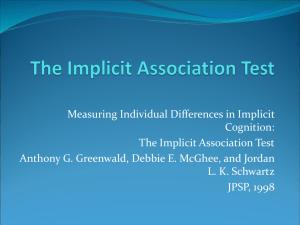
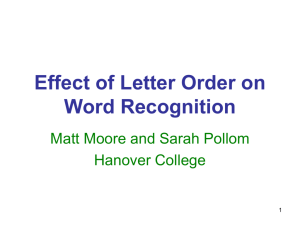
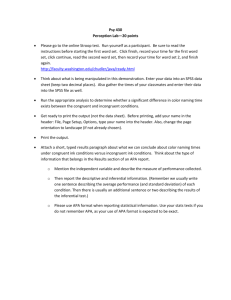
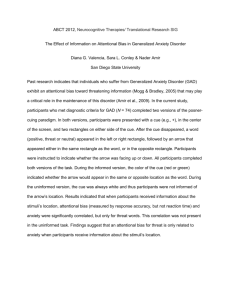
![[SZ+MA].](http://s3.studylib.net/store/data/009716128_1-5d7e208ec4c74700a98af14dc64b623b-300x300.png)
